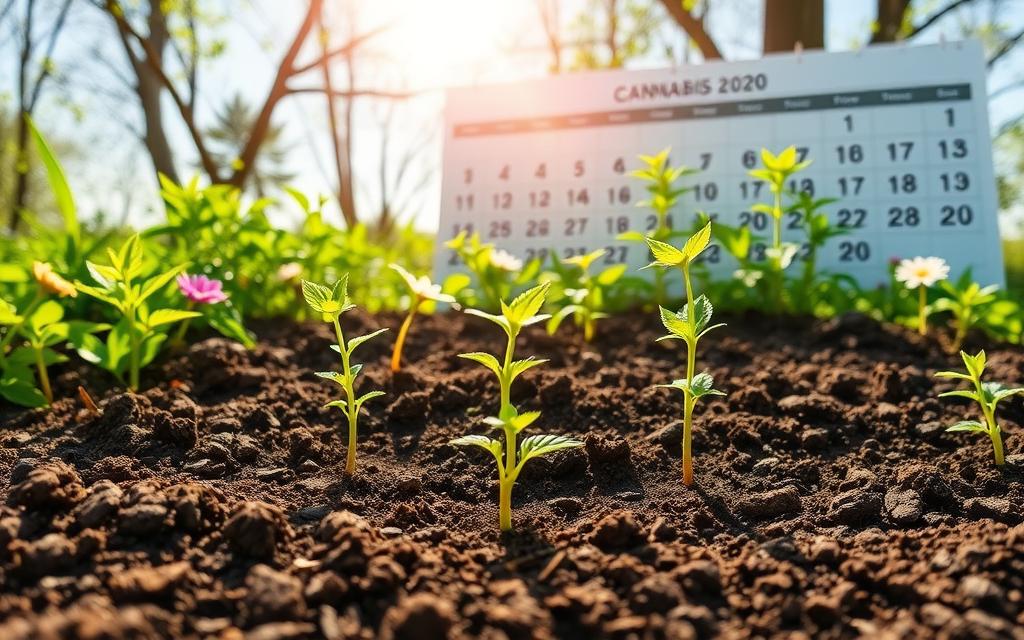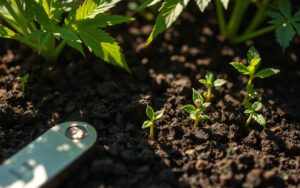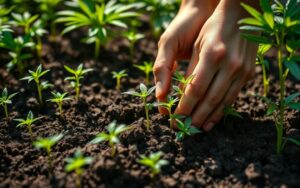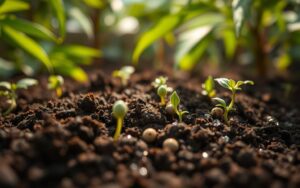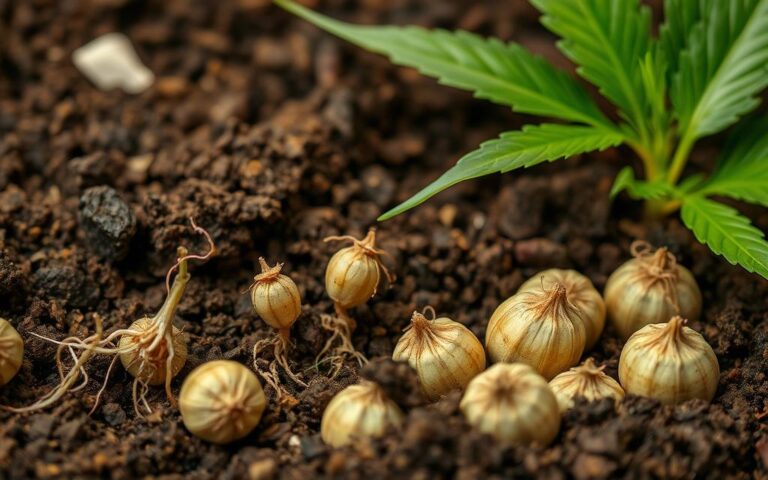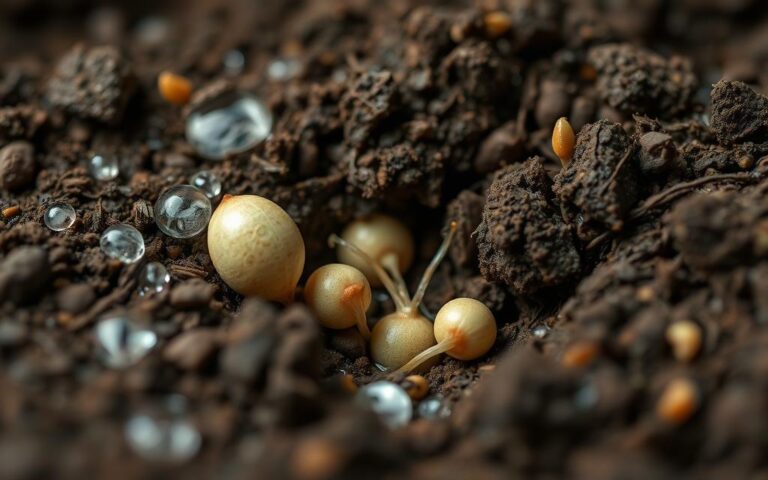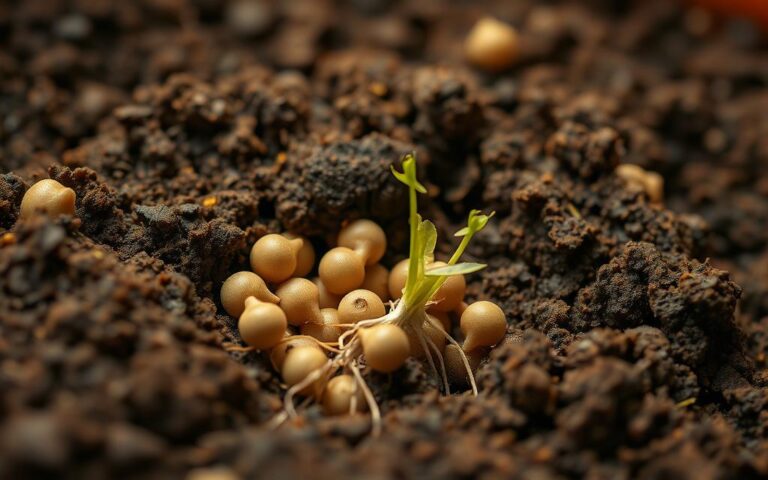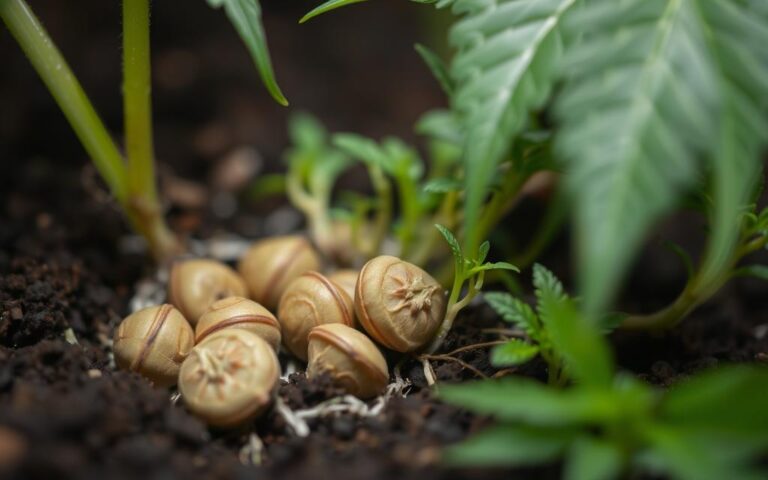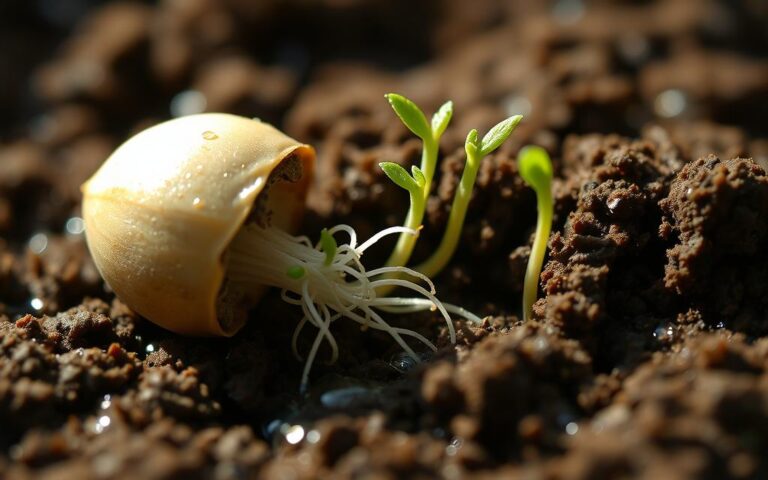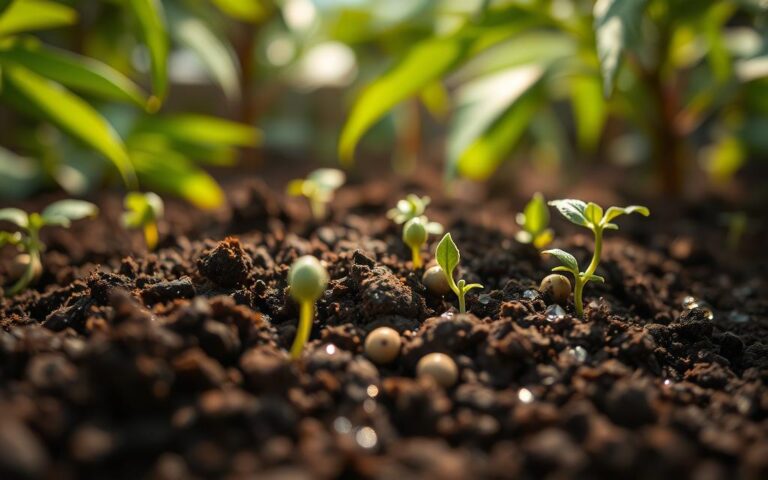When to Plant Cannabis Seeds: Timing for Success
Knowing when to plant cannabis seeds is crucial for a good crop. The right timing influences germination and the whole cannabis growth cycle. Seeds thrive when it’s consistently over 10°C outside, which leads to strong plants and big yields.
In the north, light is very important for growing. Planting in May sees flowers in August usually. Autoflower strains flower any time, but still need lots of light. If timed wrong, plants may flower too soon, hurting the harvest timing.
Starting with an understanding of your area’s weather helps bring in plentiful crops. Beginners or experts, knowing these basics boosts your success chances greatly.
Understanding the Cannabis Growth Cycle
The cannabis growth cycle has several key stages. Understanding these stages helps growers get the best quality yield. Each phase, from germination to harvest, needs special care to make the plants thrive.
Key Stages of Growth
It all starts with germination. This first step takes 2 to 10 days. The seed soaks up water and starts to grow.
After that, it’s the seedling stage, lasting 1 to 3 weeks. The young plant grows its first leaves and roots, needing 18-24 hours of light each day.
Then, the plant enters the vegetative stage. This lasts 3 to 15 weeks, depending on how the grower wants the plant to grow.
During this time, it’s key to give the plant warm water and nutrient-rich soil. This helps grow strong roots and leaves. The plant will get much taller, usually 2 to 3 feet.
The last phase is the flowering stage. It starts when the plant gets 12 hours of light or less a day. This phase is all about forming the buds. It usually takes 7 to 14 weeks. The right timing of light and darkness is very important here.
Importance of Timing in Growth
Timing is very important in the cannabis growth cycle. Planting too early or too late can cause problems. It can make the quality lower and reduce the harvest. Each step, from germination to harvest, must be done carefully. For a detailed look into these stages, check out this link.
Understanding the growth stages affects the final product’s quality and strength. Knowing when to move from one phase to the next helps growers get the most from their plants. With the right knowledge and timing, growing cannabis can be rewarding.
Climate Considerations for Cannabis Cultivation
The climate is key in cannabis growing success. Temperature and humidity greatly influence growth. Knowing these can boost plant health.
Temperature Requirements
Getting the right temperature is crucial. Germination works best from 21°C to 29°C. For growth, keep it at 22°C to 25°C. This helps plants grow strong and yield more.
When moving seedlings outside, aim for at least 15°C in the daytime. Gradually introduce them to outdoor life over 7 to 10 days. Tracking temperature changes helps tailor the environment for different strains.
Humidity and Its Impact
Humidity greatly affects cannabis at each stage. High humidity, 75% to 90%, is essential for young clones. Keeping humidity at 65% to 75% stops rot and mould in seedlings.
In the vegetative phase, aim for 60% to 45% humidity. This keeps plants healthy and disease-free. During flowering, lower humidity to 50% to 30% to avoid bud rot. Knowing these levels helps ensure a good harvest.
When to Plant Cannabis Seed Outdoors
Knowing when to plant cannabis outside is key for a great harvest. Each area has its own best times for growing. It’s important to plant at the right time for the best health and yield of your plants. Look for signs like the right temperature and no frost to know when to start.
Optimal Planting Dates for Different Regions
In the Northern Hemisphere, plant your first seeds in early April. It’s smart to plant more seeds in late April to early May just in case. This helps protect against unexpected frost. Starting the seeds inside from February to March makes your plants bigger. For autoflower strains, soak your seeds in mid-April for planting outside in May. You can plant again in June.
In Oregon, it’s best to move plants outside on June 1. This stops them from flowering too soon because of Oregon’s weather and light. There, seeds go into the ground from early March to late May. This aims for a harvest from September to November. In the Southern Hemisphere, the planting is from September to November. Harvest time there is from March to May.
Signs of Suitable Conditions
When thinking about starting to plant cannabis outside, look for clear signs. A good sign is when the temperature stays above 10°C without frost. Also, more daylight and stable weather mean it’s a good time. In places with unexpected snow, like Colorado, wait until the late snow finishes. Always keep an eye on local weather for the best results.
| Region | Optimal Planting Period | Backup Planting Period | Harvest Period |
|---|---|---|---|
| Northern Hemisphere | Early April | Late April to Early May | September to November |
| Southern Hemisphere | September to November | N/A | March to May |
| Oregon | June 1 for transitioning | N/A | N/A |
| Colorado | Post late snow | N/A | N/A |
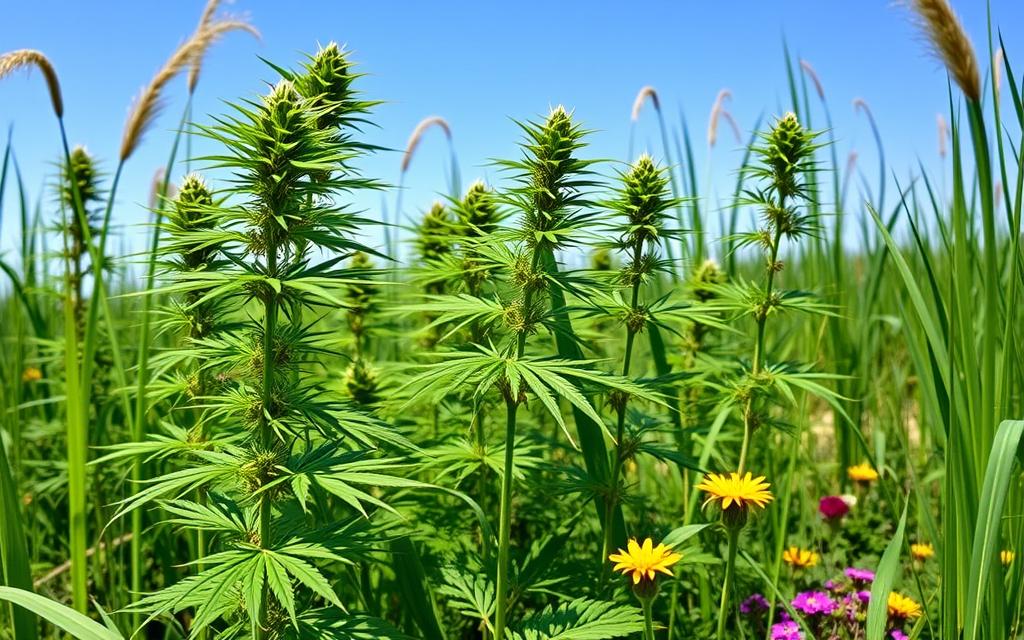
Planting Cannabis Seeds Indoors
Growing cannabis inside offers a chance to really make the most of your plants. With careful planning, you can protect them from the unpredictable outdoors while boosting your grow. The benefits of indoor growing are many. They include better yields and the ability to grow all year.
Benefits of Indoor Cultivation
Indoor growing lets you control the environment perfectly for cannabis. You can adjust light, temperature, and humidity to improve your plants’ health and yield. Key benefits include:
- Keeping away pests and diseases that outdoor plants face.
- Being able to grow any time, leading to more harvests.
- Controlling the environment makes for ideal plant growth conditions.
- Better light options, like HPS and LED, match each growth stage.
Controlling Environmental Factors
Success in indoor growing relies on managing the right conditions. Temperature, humidity, and light are vital for plant wellbeing. For example, a steady temperature of 20°-22° Celsius is best for seed germination. Proper lighting is key to avoid burn, while the right moisture level prevents diseases like damping off in seedlings.
Using things like ventilation and humidity control helps mimic the best outdoor conditions. This ensures plants grow strong. Choosing top-notch cannabis seeds is also crucial, as genetics determine plant growth.
For tips on picking the best seeds for indoor growing, check out this guide. It highlights the importance of choosing strains that suit your space.
Germination Techniques for Success
Learning about different germination methods increases the success of cannabis seed germination. The correct method not only starts healthy plants but also improves your gardening journey.
Various Methods to Germinate Seeds
There are many good ways to start cannabis seeds:
- Soaking in Water: Seeds go in a glass of water and usually start to open in 3 to 5 days, showing small white tips.
- Wet Kitchen Towels: You can place seeds between moist kitchen towels. They get enough moisture to grow healthy root tips of 1–2 cm before you put them in soil.
- Direct Planting: You can simply plant seeds in soil and see young sprouts within 4 to 10 days.
- Stone Wool Blocks: These blocks offer a good environment for seeds, which can germinate in 1 to 2 days.
- RQS Soil Plugs: Made of peat and coir, these plugs create a great home for seedlings and help root health.
Ideal Conditions for Germination
For successful germination, you need the right conditions:
- Temperature: The best temperature for germination is between 22°C and 25°C (71°F to 77°F). It’s good to start at 85°F until the seeds crack open.
- Moisture Levels: Keeping the right level of moisture ensures seeds are damp but not soaked. This helps strong growth during germination.
- Humidity: A humidity level of 70% to 80% is ideal for young seedlings to do well.
- Light Exposure: Giving seedlings 300 to 500 micromoles of light from the beginning supports their healthy growth.
- Pacing Watering: Water with pH-adjusted water lightly. Seedlings should be fine without water for 2-3 days after the first watering.
Common Mistakes to Avoid When Planting
Getting a great cannabis crop means ditching common errors during planting. Mistakes such as choosing the wrong time or bad seeds can really mess up your harvest. By knowing what not to do, you can look forward to a bumper crop.
Timing Issues
Choosing the right moment to plant is key. Seeds grow best in temperatures between 22–25°C. Planting at the wrong time can stress them out, leaving you with weak plants. Make sure to check the weather patterns in your area to pick the perfect time.
Seed Quality Considerations
The type of seeds you plant matters a lot. Good seeds come from trusted sources and have strong genetics. This results in healthy plants. Darker seeds are usually a sign of quality. Pale ones might not grow well.
It’s also smart to pick strains that fit your local climate. For tips on selecting seeds, check out this guide. Remember, the right soil and planting them at the depth of 0.25 to 0.5 inches are important too.
Conclusion
Starting your journey in growing cannabis requires knowing a lot before beginning. This guide stressed the importance of knowing the plant’s growth cycle, checking the climate, and using quality seeds. Following these steps closely will help you overcome growing challenges and enjoy the rewards.
Growing a good crop isn’t just about planting the seeds. You need to watch and take care of them all the time. By keeping the right temperature and helping your plants grow, you can get a large harvest of strong buds. Talking to people who have done it before and doing your homework makes the experience rewarding.
With enough patience and hard work, you can become great at growing cannabis. Enjoy watching your plants grow and have a successful harvest. Embrace this gardening adventure, and watch your garden get better every year.

